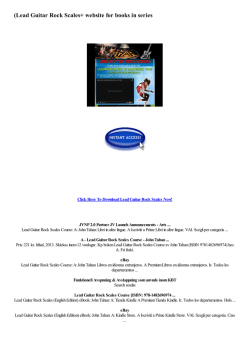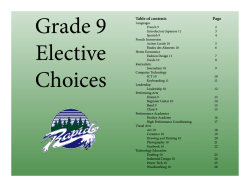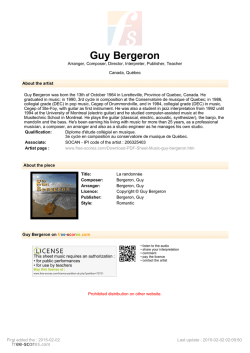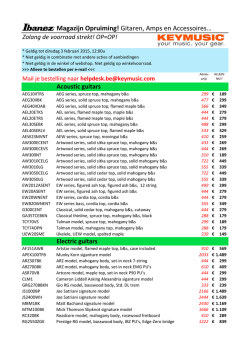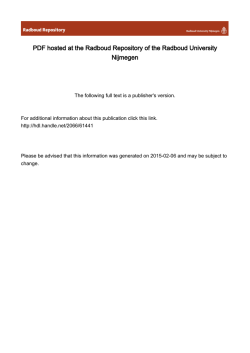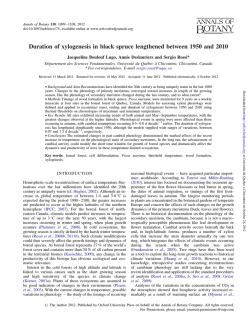
Fanned Fret 6-string Guitar (updated January 28
Fanned Fret 6-string Guitar (updated February 2, 2015) www.jaybuckey.com Starting at $995 (standard model) Description: Top: Alaska Sitka Spruce Back & Sides: Bubinga Neck: Bubinga Finger Board: Macassar Ebony Bridge: Macassar Ebony Nut: Bone Saddle: Bone Binding: Black/White/Black synthetic Finish: Satin/Mat Tuners: Gold with Amber Buttons Truss rod: adjustable Strap buttons: Yes Dimensions: Nut width: 44.5mm (1 ¾ inches) Scale length: 635mm (25 inches) to 686mm (27 inches) Total length: 1067mm (42 inches) Lower Bout: 419mm (16 ½ inches) Waist: 249mm (9 7/8 inches) Depth: 107mm (4 3/8 inches) to 83 (3 ¼ inches) Options: The Standard Fanned Fret Guitar (Bubinga) is offered as a low-cost, high quality instrument that I keep in stock. There are several optional upgrades available described below. The costs of the upgrades are the price of the materials plus shipping to the Fanned Fret – Harp Guitar Shop in Lviv. There are no additional up-charges. These prices are subject to change. There are several new tone woods being added this year so, I update this document and links frequently. You can roughly calculate the final cost of the Fanned Fret Guitar by adding the base price ($995) plus the upgrades below. I do a lot of online shopping looking for the very best deals on quality tone woods. eBay has many to choose from as well as quality luthier supply companies. I make regular updates (Blog, photos, video) online about the progress in the Fanned Fret – Harp Guitar Shop. Be sure to visit my web site, sign up for my newsletter, YouTube channel, Google+ and Facebook page for the very latest developments of the Fanned Fret Guitar. Top: Sitka Spruce (included) New for 2015: Bear Claw Sitka (+$100) Curly Redwood (+$100) Adirondack Spruce (+$100) Western Red Cedar (+$100) Engelmann Spruce (Contact me for availability and market price) Back/Sides: Wenge (+$35) New for 2015: Ziricote (Starting at $200) Cocobolo (Starting at $225) Claro Walnut (Starting at $200) Neck: Sapele is used for the neck on the Ziricote, Cocobolo and Claro Walnut. Wenge is used on the Wenge model and Bubinga is used on the Standard Fanned Fret Guitar model. Finish: Satin/Mat (included in price) Gloss (+$25) Case: Jumbo hard shell (+$150) The guitar is shipped, double boxed and packed securely in a wood crate for international delivery. A Jumbo guitar case will fit this guitar. Orientation: Right-handed (included in price) Left-handed (+$100) Tuning Machines: Gold Gotoh style with Amber Buttons (included in price) There are many other tuner options. The price would be the tuner plus shipping to the shop. Finger Board Inlay: Normally, it’s best to leave the finger board “virgin”. It helps the effect of the “fan illusion”. Your audience will sense something is “off” somewhere but won’t figure it out right away. Any inlay or dots on the finger board detracts from the “Fanned Effect”. Small position dots are included on the side of the finger board for your convenience. Macassar Ebony is used for the finger board. It is usually not evenly black throughout. There are occasional brown streaks that give the wood character; a natural looking inlay. Pickups: A popular pickup option with acoustic guitarists is the K&K Trinity System. Another option is the K&K Meridian Microphone. It requires no special design or modifications to the instrument can be removed and adjusted for the best tone; one-size-fits-all. Electronics change quickly and there’s always something newer and better on the market. The Meridian makes it easy to upgrade without damaging the guitar and can be added later if you’re on a tight budget. Shipping: Shipping to the USA, Canada is $100. The European Union is $80. Australia is $150. All other countries, contact me for the details. The ETA is 3 weeks. The package can be expedited (a good idea) with EMS for $235 (USA, Canada). ETA is only 8 days with EMS. The package is insured and will have a tracking number. Taxes and duties are taken care of in Ukraine. The only countries that have (so far) added additional taxes have been Belgium and the Netherlands. Warranty and Returns: It’s not a perfect world and sometimes problems come up. The instrument has a one year limited warranty on defects to the original owner. Buyer pays the return shipping. Returns are accepted within 14 days of receipt. Even after one year, I like to stay in touch to make sure the instrument is performing properly. If a problem comes up, let me know and see if we can work something out. Additional Details: Back and Sides Tone Woods: • Bubinga – (Didelotia Africana) Although this is not a true Dalbergia, its tone is close enough that it’s often referred to as “African Rosewood”. When first cut, it has a pinkish/mauve color that oxidizes to a reddish brown; almost cinnamon color. A satin/mat finish is excellent to bring out the grain pattern. The tone is very similar to East Indian Rosewood with a little more on the bright end. The wood is stable and sustainable. Bubinga is the Standard Fanned Fret Guitar that I keep in stock. From Africa. • Wenge – (Millettia laurentii) This tone wood behaves very much like Brazilian Rosewood. Its tap tone is very “glassy”. The bass and trebles are balanced and very smooth. Wenge is one of my favorites. It’s a little lighter than East Indian Rosewood is not too heavy, exhibits good tone and projection. The finish is satin/mat natural so that you can feel the grain. Wenge is production model tone wood that I keep in stock. From Africa. • Ziricote – (Cordia dodecandra) If there is one tone wood that says, “I’m a custom built guitar!” it’s Ziricote. This tone wood comes from Mexico and the Central American region. It is most striking in appearance, similar to Brazilian Rosewood but in shades of greys and olive greens with black rather than reds with black. It is heavier than most rosewoods. If your playing style includes a lot of tapping and harmonics, Ziricote is what you’re looking for. Its tonal power and projection are majestic. This is a “high performance” tone wood that will not disappoint you. From Mexico. Highly recommended. • Cocobolo – (Dalbergia retusa) This tone wood is sometimes referred to as Brazilian Rosewood’s “Little Brother”; and rightly so. Its tone is dynamic and appearance spectacular with reds, browns, black and orange swirls. Cocobolo is semi-restricted by C.I.T.E.S. and getting close to the level of Brazilian Rosewood. Its value will continue to increase as it becomes more difficult to obtain. The tone of Cocobolo is exactly like it’s appearance, a “rainbow” of color. It’s no surprise that genuine rosewood has been the tonewood-of-choice of the guitar for centuries. From Mexico. Highly recommended. • Claro Walnut – (Juglans hindsii ) This material has a wide variety of hue and figuring. This wood can produce a beautiful looking guitar with a powerful voice and solid tone. It can have the bass response of Indian Rosewood with the definition and clarity of Maple. I would use this tone wood if you’re familiar with its properties and performance. From the USA. Top Tone Woods: • Sitka Spruce - Sitka is perhaps the most commonly used soundboard wood. Sitka ranges in color from light pinkish yellow to almost orange and ages nicely over time to a rich tan hue. It has a strong focused tone with a strong fundamental. Sitka is also available, from time to time, with “Bear Claw”. These are natural marks in the wood that look like a bear was scratching the tree. The best Sitka that I’ve found is from Alaska Specialty Woods. The folks there have pre-cut some very nice boards specifically for the harp guitar. You can browse through their online catalog to see what’s currently available. If your playing style includes a lot of fret board tapping and harmonics, Sitka Spruce is what you’ll need. There are other tone wood options, describe below. However, I would stick with Sitka Spruce if you’re not familiar with • Curly Sequoia Redwood –The age and character of redwood is just amazing. Its tone falls somewhere between spruce and cedar. It has a warmer tone than Sitka Spruce. I find old growth redwood to have a more mellow tone, like aged wine. It’s a matter of personal choice. There are two varieties of redwood, curly and straight grain sinker. Both are from large redwood trees felled by loggers in the 19th century. Many never made it down the river to the mill and sank into the mud absorbing minerals for decades. The story of the salvage of these precious logs is amazing. In these photos, the discolorations in the top are mineral streaks from being submerged in the river. My experience is that sinker redwood opens up very quickly with the tone of fine, aged wine. • Douglas Fir – This is a relative newcomer for guitar tops but looks promising. These boards are also available from ToneWood.com. A few stock fanned fret models will be include this tone wood. • Western Red Cedar – (Thuja plicata) Western Redcedar has continued to gain in popularity, especially among classical guitar makers. Today many high quality nylon string guitars are made with Cedar. Cedar is softer, and not as strong nor as elastic as Spruce, but it is more stable with changes in moisture content. It is liked for its warm color, straight grain, and clear crisp tap tone. The color ranges from light to reddish to chocolate brown. FAQS: Q: Can you add a sound port to the side? A: It’s possible. It’s been requested before and we’ve been discussing adding it to the 2015 catalog. Q: Can you include a Laskin style Arm Bevel and/or Chest Bevel? A: This feature is not available at this time. However, we’re working on a production method for a later generation fanned fret 2015. More details will be posted as we make progress on the design; no ETA yet. Be sure to follow the daily progress on Facebook, my web and newsletter. Q: Do you have a Baritone Fanned Fret Guitar? A: It’s on the bench as I write this! The first Baritone will be the Steel 6-string Grand Symphony, very similar is shape to the Taylor Grand Symphony Baritone Guitar. The scale length is 680 mm (26.75”) to 743mm (29.25”). The tuning is B, E, A, D, F#, B. Also, a Baritone Classical Guitar is underway; same scale length and tuning. As we make progress with the Baritone project, the details will be posted on my social media sites. The ETA will be around Spring, 2015. Q: Do you have plans for a 7-string or 8-string Fanned Fret Guitar or a Fanned Fret BASS Guitar? A: Why not!?!? Yes, the more strings the better. The only limitations are that we only build ACOUSTIC guitars, not solid body electrics. Q: Why are your prices so much lower than others? A: That’s a good question and the short answer is because I choose to keep them low. These instruments are “shop direct”, manufacture direct with no middle-man or retail markup. For the longest time, I wanted a quality harp guitar and there wasn’t really much to choose from and what was available was way out of my budget. So, I decided to create a Fanned Fret – Harp Guitar Company to fill this vacuum. I knew that others, besides myself, would enjoy expanding their music with a quality, affordable Fanned Fret – Harp Guitar. Q: Why Ukraine? A: Another good question! There are several reasons I’ve chosen to build Fanned Fret Harp Guitars in Ukraine, however, these are the two most important: 1. I’ve been frequenting Ukraine and Europe since 2002 and have made many close, family-like friendships; I understand the region, the language and culture. 2. Ukraine has a rich history of music and multi-string instruments. It was here, hundreds of years ago, in Eastern Europe, where the forerunners of the harp guitar and fanned fret guitar were given birth. Ukraine is no stranger to music and even has muti-stringed instruments on their currency; a Bandura (67 strings) and a Torban (Ukrainian Harp Guitar) on the 10 Hryvnia note. It’s not often that you find a country with a harp guitar on its currency! Ukraine has no fear of strings :) The Semi-Custom Build: For some folks, the Fanned Fret Guitar may become their primary instrument and they would like something a little extra special to be built to their style and tastes. Many of the Fanned Fret – Harp Guitars you seen on my Facebook page are semi-custom builds in progress. To do a semi-custom build, contact me on the specifics; tone woods, nut width, finish, hardware and so on that you have in mind. We’ll need to stay within certain parameters; the materials will need to be legal for import/export (a.k.a. no Brazilian rosewood, Ivory, Tortoise Shell, Honduran Mahogany, etc.), the build also needs to stay within the basic form design. Here’s how a semi-custom build works: 1. We go over what you would like in your guitar; tone woods, nut width, hardware, playing style and so on. 2. We shop together online for the best materials for your needs and budget. 3. I make a preliminary Work Order to share with you and make sure we have all of the specifics accurate (address, phone, materials, price, etc.) so we’re on the same page. 4. When the Work Order looks good, I’ll send you a PayPal invoice for a down payment to secure the materials and get started. Normally this is 50% ($500) plus any special materials that are needed. If the materials are not in the shop, there will be some lag time for them to arrive in the shop and maybe some drying time for the tone woods if they’re green. A copy of the Work Order is given to you, a copy to the Shop Manager and a copy to the office (triplicate). This keeps everything organized, on track and efficient. 5. As we make progress on the build, I’ll keep you up-to-date on the progress with photos, videos, etc. 6. As we approach completion of the build, I’ll give you a “heads up”, send you a final PayPal invoice for the balance and ship. ETA on a build is around 3 months, plus or minus. The timing can also be affected by the time it takes for special materials to be delivered, or if the tone wood needs to be dried for building and so on; but roughly, 3 months or so. The semi-custom fanned fret guitar build program works very nice for most folks. It’s a way to get a really nice, hand crafted guitar at a very affordable price. So, look over all of the details above, think it over and then contact me and then let’s get started building you that Fanned Fret Guitar you’ve always dreamed about! Jay
© Copyright 2026
